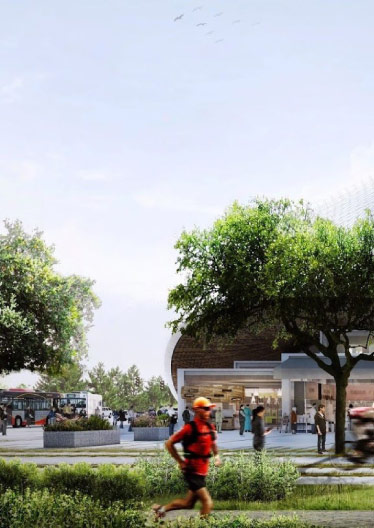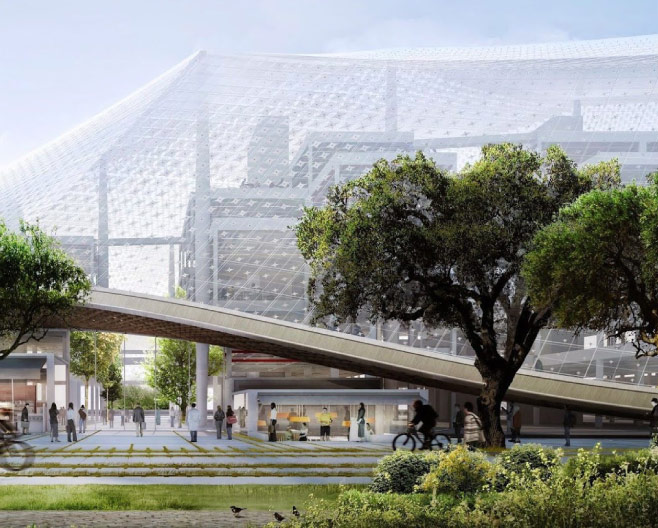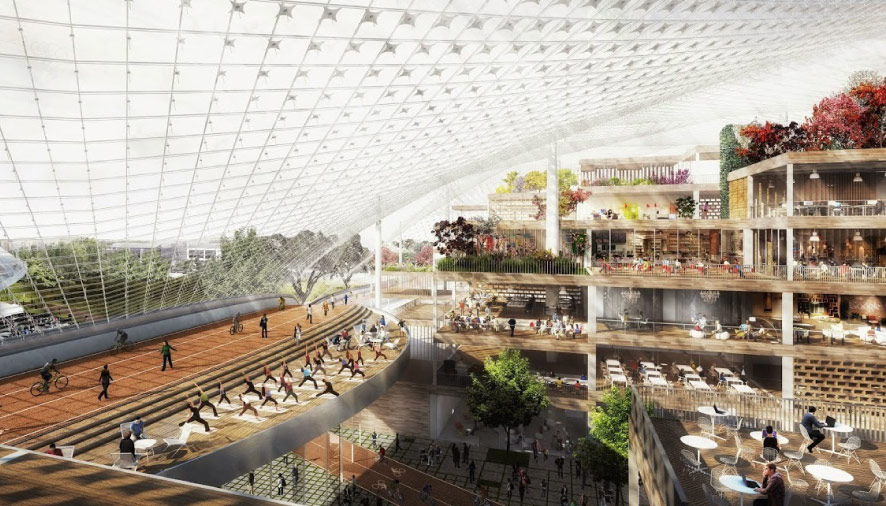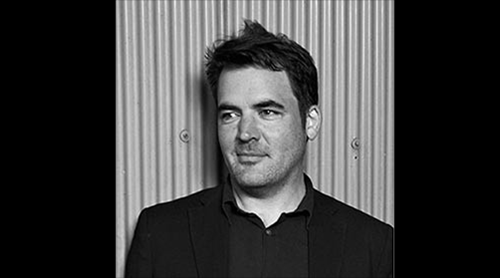-
Machines of
Loving GraceThe city as a distributed robot & the omnipresent intelligence of data networks
Text by Sam Jacob
Illustrations by Daniel Dociu -
Architect Sam Jacob takes us on a not-so-futuristic journey from the strategic datascape of the contemporary battlefield to built environments with embedded intelligence. And he finds the “machines” that control us to be disturbingly unaccountable.
If you were to conduct an archaeology of visions of the future, from the mounds of speculative dirt you’d dig up a vast array of artificial humanoid limbs and metallic heads. These are the synthetic body parts of a Maschinenmensch future that has yet to come to pass. But then science fiction is always about the present, so an archaeology of science fiction is a history of hopes and fears frozen in fictional form. The robots that inhabited these fictions were not technological entities but philosophical ones – images of ourselves rendered in ways that let us imagine what it might still mean to be human in worlds transformed by progress. Our cities remain free of these technological doppelgängers but that doesn’t mean these same paranoias and dreams are not part of our world.
If you want to see what the future of the city might be you only have to look at the recent battlefields of Afghanistan. Here was a networked field, a military internet of things, connecting people, objects and their flows through space, in a three dimensional matrix of technology. Above, flocks of satellites, planes, helicopters, drones and aerostats. On the ground, swarms of sensor-augmented vehicles, teched-up soldiers and a cohort of robot devices.
All of this controlled by an invisible tactical communications network that stretched from the local to the global. Biological units, equipment, their robotic menagerie and their remote directors cast an invisible net across the landscape. A net that surveyed the landscape, gathered data and intelligence, communicated it, processed it and in turn remote-commanded movement and logistics in a constant choreography of lethal force. -
Like the eyes of MQ-9 Reaper drones connected through electromagnetic optic nerves to their pilots back in Las Vegas, it was both there and not there. The technology of warfare as deployed in Afghanistan was an undoubted occupation of space but simultaneously distanced from that very same space. The rise of remote-ness – of drones and robots patrolling sky and ground – was a new level in the rendering of landscape as strategic datascape. All the better to monitor and maintain security with the greatest efficiency possible – at least in theory.
The battlefields of Afghanistan have been de facto experiments in new forms of networked spatial practice, the kind of space that is coming soon to a city near you.
The relationship between military practice and urbanism is nothing new of course. It has a long and noble history: from fortifications as military device to their re-emergence as suburban decoration; in the radical radial reconstruction of Paris by Baron Haussmann into easily surveyed boulevards; in the contemporary use of green-zone type defences around potential urban targets; even in the origins of the architectural axonometric projection as a means to three-dimensionally plot the trajectories of artillery shells. This history often describes a process where ideas tested in exceptional military conditions first are later imported into the normality of urban life. For us that means: first Helmand, then Hampstead.
The tactics and technologies of the contemporary military field serve as a (literal) avant-garde of the new urban concept of the smart city – a useful point of reference if we want to picture what it might mean because the idea of the smart city is as pervasive as it is hazy. What it suggests is an idea that merges technological promise with green futures, of automation and regulation of flow, all providing an increasingly frictionless form of urbanism. Devices, machines, buildings, infrastructure in constant information-jabber aimed at optimised efficiency.
It is a dream of a built environment with embedded intelligence, of huge amounts of live data streams processed by algorithms that in turn feedback into the physical choreography of the city. The smart city, it’s suggested, will transform government services, transport and traffic management, energy, health care, water and waste – pretty much everything. It addresses gigantic issues of climate change, economic restructuring, ageing populations, pressures on public finances and the very idea of urban democracy. In other words, the smart city promises (and threatens) to transform our entire urban milieu. The social, physical, political, economic and environmental realms of the city will be (is) reframed by the “intelligence” generated by massive data harvesting and processing.
This smart-dream-future of the city might only now be beginning to happen but it has a long history – one that originates in a very different place. -
In 1967, Richard Brautigan, poet in residence at California Institute of Technology, published All Watched Over By Machines of Loving Grace. The poem described a Haight-Ashbury techno fantasy. Here is an extract:
I like to think
(it has to be!)
of a cybernetic ecology
where we are free of our labors
and joined back to nature,
returned to our mammal
brothers and sisters,
and all watched over
by machines of loving grace. -
The text was printed over an image of electric schematics and it set out a utopian vision of a techno-pastoralism, where new digital machines could return us to a prelapsarian state, at one with nature in an electric Eden.
Within architectural culture, a similar idea was expressed in Archigram/David Greene’s Bottery (1969) conceived as “a fully-serviced natural landscape”, an invisible built environment that would let you “do your own thing” manned by patrolling bots providing services and nodes disguised as landscape features in the form of Log and Rock Plugs dispensing data and power. Just as with Brautigan, technology is figured as a liberating force whose sophistication would allow us to return to an innocent “natural” state.
Greene describes a “bot” as a “Machine Transient In the Landscape” and the contents of the Bottery as:
1. (An architecture of) Time
2. Planet Earth Spacegarden
3. Some existing hardware
4. Some new hardware
5. The idea of the invisible
He writes that the “Bottery is part of the idea of the Spacepark Earth” and for further details “write to Sierra Club Foundation, Mill Tower, San Francisco, California”.
These kind of late 60’s zippy ideas were – and remain – central to the West Coast techno-utopian dream. Think of Apple Inc., now the most valuable company in the world but named after the orchards of the All-One Farm commune set up by a charismatic, free loving, LSD propagandist. Think of the gigantic techno-Xanadus currently under construction. Of Apple’s perfect sleek Jung circle (complete with its own apple orchard), designed by Foster; of Amazon’s Bucky-bio-sphere-redux; of Google’s BIGwick mega-bottery replete with robot-construction drones.
These are places that are far more than office complexes. They are nothing less than 21st century versions of the kinds of ideal communities, model villages, and utopian settlements that were the foundation of modern urban planning. Modern day Port Sunlights and Bournvilles, high tech versions of Robert Owen’s New Harmony. These historical examples are significant not just as worker towns but places founded with profound reformist and idealistic principles. They demanded certain forms of behaviour and outlawed others, they figured their communities around micro-models of how the world could /should be. -



Inserted GIF: New Apple HQ designs, Foster + Partners. (Image Courtesy Apple Inc.)
-



Google Self-driving Car; Google HQ renderings. (images courtesy BIG)
That’s how we should view these new tech-campus-worlds too, as contemporary model villages. As places that embody (and enforce) entire world views, as complete models of new forms of society organised around particular ideas of technology. And like their Victorian counterparts they promote a particular idea of society. Bundled into code and chips is an unstated ideological idea of how the world should be organised, and who should be organising it as well.
But, unlike their historical precedents, these new corporate models of society are not limited to the boundaries of their own real estate. With the global reach these corporations have – at scales beyond that of the city and the state – and with the depth of penetration into the minutiae of our lives, their ideas about the organisation and function of society are now all-pervasive. They are the backbone of the global model of the smart city. Everywhere is – or soon will be – California in all but name.
Away from the giants of consumer-facing technology are those involved in the (big) business of “smartifying” our cities (Arup estimate the global market for smart urban services by 2020 will be $400 billion annually). Companies like Cisco and Siemens are deeply involved in implementing smart initiatives in cities across the world. Meanwhile the likes of Uber and Airbnb are transforming specific models of urban organisation so fast and furiously that we can only expect more traditional urban models to be fundamentally reinvented.
But as this is unfolding so too is a crisis in the idea of the city as a democratic space. The smart city is, mostly, an outsourced city. -
Vote for whoever you like, they say, you will still get Serco – one of the giants of municipal service provision. Their tag line promises to “improve services by managing people, processes, technology and assets more effectively”. Say you are a city – or a state for that matter – Serco can help you by “providing safe transport, finding sustainable jobs for the long-term unemployed, helping patients recover more quickly, improving the local environment, rehabilitating offenders, protecting borders and supporting the armed forces” …amongst a host of other things traditionally delivered by the state and municipality itself.
Is Serco’s promise any different from those “machines of loving grace” that Brautigan imagined? Is it yet another of those 1960s dreams of freedom returned to us through deregulated neoliberalism? Are we watched over with loving grace but also by machines with suspicion in their eyes? -

Sam Jacob is principal of Sam Jacob Studio for architecture and design. His work ranges from master planning and urban design through architecture, design and art projects.
Previously, Jacob was a founding director of FAT Architecture where he was involved in many internationally acclaimed projects including the BBC Drama Production Village in Cardiff, the Heerlijkheid Hoogvliet Park and Cultural Centre in Rotterdam and the curation of the British Pavilion at the 2014 Venice Biennale. He has exhibited at leading galleries and museums including the Victoria & Albert Museum in London, the MAK in Vienna and the Biennale in Venice.
Jacob is Professor of Architecture at the University of Illinois at Chicago; Visiting Professor at Yale School of Architecture and Director of Night School at the Architectural Association. He is also contributing editor for Icon magazine and columnist for both Art Review and Dezeen.
samjacob.com
Daniel Dociu is a sci-fi and fantasy artist who was raised in Cluj, the capital of Transylvania in Romania, where he also studied art and architecture at the Academy of Fine Arts. He moved to the US in 1990 and has lived in the Seattle area for over 20 years.
After working as a toy designer, Dociu switched to interactive entertainment. For the past nine years, he has been with ArenaNet, in Chief Art Director role NCsoft, overseeing visual development for all of the publisher's North American projects, with particular focus on the critically acclaimed Guild Wars franchise. He is also a prolific freelance artist, contributing to numerous publications, advertising and film.
danieldociu.weebly.com
The dislocation of the provision of urban services, whether officially privatised or not, from the city itself to global multinationals such as Uber, Google, Apple, Cisco or Serco, dislocates us as citizens from the inherent politics of those services. They are here but not here, as locally unaccountable as Vegas-based drone pilots.
Physically, the future city is a place where everything is itself and, variously equipped with sensors, computing power and autonomous mobility, also something else. If cars are reinvented as driverless devices they become things that move us and things that regulate that movement at one and the same time. Street furniture is recast as both comfort and control. In other words, Greene’s Log Plug acts as a precursor to the transformation of the entire city fabric into both thing and node. In other words, the bot is everything and everywhere. The city itself is a distributed robot, a collection of sensors and functions linked through invisible networks of communication.
What does that make us as the citizens of these new smart cities? Are we condemned to be prisoners in an all-seeing digital panopticon of street benches? Are we suspect-citizens leaving data-trails across the urban landscape? Or are we liberated to become friction-free smart citizens in a new form of ultra-fluid urbanism doing our own thing?
Most likely both. As smart citizens we buy into the future of the city by equipping ourselves with phones, apps, RFID chips, driverless cars, networked homes and whatever else we can afford. Why? Because the attraction of the smart city is so great, because it is so convenient and because it does make us feel free. We are, in other words and to coin a phrase, voluntary prisoners of smart architecture. p
-
Search
-
FIND PRODUCTS
PRODUCT GROUP
- Building Materials
- Building Panels
- Building technology
- Façade
- Fittings
- Heating, Cooling, Ventilation
- Interior
- Roof
- Sanitary facilities
MANUFACTURER
- 3A Composites
- Alape
- Armstrong
- Caparol
- Eternit
- FSB
- Gira
- Hagemeister
- JUNG
- Kaldewei
- Lamberts
- Leicht
- Solarlux
- Steininger Designers
- Stiebel Eltron
- Velux
- Warema
- Wilkhahn
-
Follow Us
Tumblr
New and existing Tumblr users can connect with uncube and share our visual diary.
»Architectural interpretations accepted without reflection could obscure the search for signs of a true nature and a higher order.«
Louis Isadore Kahn
Keyboard Shortcuts
- Supermenu
- Skip Articles
- Turn Pages
- Contents


